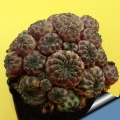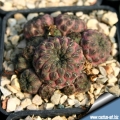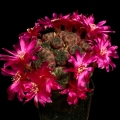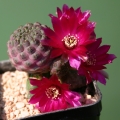




Your support is critical to our success.
Acta Mus. Richnov., Sect. Nat. 14(4): 95. 2007 [Dec 2007]
Family: CACTACEAE
= Sulcorebutia rauschii G.Frank
Kakteen Sukk. 20: 238. 1969
Accepted Scientific Name: Rebutia canigueralii Cárdenas
Cact. Succ. J. (Los Angeles) 36: 26, figs. 1964
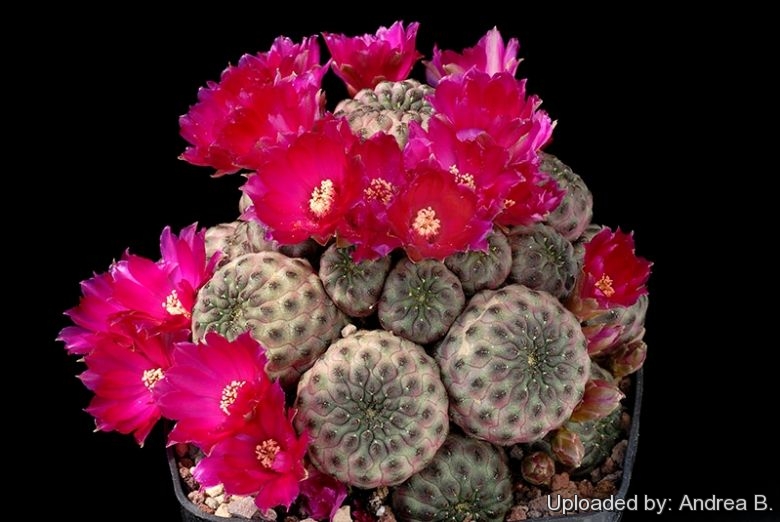
Field number: HS121-1 Collector: Heinz Swoboda Locality: Cerro Flor de Aikampa, Zudañez, Chuquisaca, Bolivia 2700m. The magnificent dark purple blooms.
Origin and Habitat: Sucre, Chuquisaca, Bolivia
Synonyms:
- Sulcorebutia rauschii G.Frank
- Rebutia rauschii (G.Frank) D.R.Hunt
- Sulcorebutia tarabucoensis subs. rauschii (G.Frank) Halda & Malina
- Weingartia rauschii (G.Frank) F.H.Brandt
Rebutia canigueralii Cárdenas
Cact. Succ. J. (Los Angeles) 36: 26, figs. 1964
Synonymy: 88
- Rebutia canigueralii Cárdenas
- Sulcorebutia canigueralii (Cárdenas) Buining & Donald
- Weingartia canigueralii (Cárdenas) F.H.Brandt
- Rebutia caracarensis Cárdenas
- Sulcorebutia caracarensis (Cárdenas) Donald
- Weingartia caracarensis (Cárdenas) F.H.Brandt
- Rebutia inflexiseta Cárdenas
- Rebutia pulchra Cárdenas
- Rebutia canigueralii subs. pulchra (Cárdenas) Donald ex D.R.Hunt
- Sulcorebutia pulchra (Cárdenas) Donald
- Weingartia pulchra (Cárdenas) F.H.Brandt
- Rebutia vasqueziana (Rausch) D.R.Hunt
- Sulcorebutia losenickyana var. vasqueziana (Rausch) K.Augustin & Gertel
- Sulcorebutia vasqueziana Rausch
- Weingartia vasqueziana (Rausch) Hentzschel & K.Augustin
- Sulcorebutia alba Rausch
- Sulcorebutia vasqueziana subs. alba (Rausch) Fritz & Gertel
- Weingartia alba (Rausch) F.H.Brandt
- Sulcorebutia albaoides (F.H.Brandt) Pilbeam
- Weingartia albaoides F.H.Brandt
- Sulcorebutia albaoides var. subfusca (F.H.Brandt) Pilbeam
- Sulcorebutia callecallensis (F.H.Brandt) Pilbeam
- Sulcorebutia tarabucoensis var. callecallensis (F.H.Brandt) K.Augustin & Gertel
- Weingartia callecallensis F.H.Brandt
- Weingartia tarabucoensis var. callecallensis (F.H.Brandt) Hentzschel & K.Augustin
- Sulcorebutia canigueralii var. applanata (Donald & Krahn) Horáček
- Sulcorebutia canigueralii f. applanata Krahn
- Sulcorebutia verticillacantha var. applanata Donald & Krahn
- Sulcorebutia croceareolata (F.H.Brandt) Pilbeam
- Weingartia croceareolata F.H.Brandt
- Sulcorebutia fischeriana K.Augustin
- Weingartia fischeriana (K.Augustin) Hentzschel & K.Augustin
- Sulcorebutia frankiana Rausch
- Weingartia frankiana (Rausch) F.H.Brandt
- Sulcorebutia frankiana var. aureispina Rausch
- Weingartia aureispina (Rausch) F.H.Brandt
- Sulcorebutia inflexiseta (Cárdenas) Donald
- Weingartia inflexiseta (Cárdenas) F.H.Brandt
- Sulcorebutia losenickyana Rausch
- Sulcorebutia vasqueziana subs. losenickyana (Rausch) Gertel & Šída
- Sulcorebutia vasqueziana var. losenickyana (Rausch) Šída
- Sulcorebutia verticillicantha var. losenickyana (Rausch) Oeser
- Weingartia losenickyana (Rausch) F.H.Brandt
- Weingartia vasqueziana var. losenickyana (Rausch) Hentzschel & K.Augustin
- Sulcorebutia pasopayana (F.H.Brandt) Gertel
- Weingartia pasopayana F.H.Brandt
- Sulcorebutia perplexiflora (F.H.Brandt) Pilbeam
- Weingartia perplexiflora F.H.Brandt
- Sulcorebutia rauschii G.Frank
- Rebutia rauschii (G.Frank) D.R.Hunt
- Sulcorebutia tarabucoensis subs. rauschii (G.Frank) Halda & Malina
- Weingartia rauschii (G.Frank) F.H.Brandt
- Sulcorebutia rauschii f. aureispina hort.
- Sulcorebutia rauschii f. cristata hort.
- Sulcorebutia rauschii f. violacidermis hort.
- Sulcorebutia rauschii f. viridermis hort.
- Rebutia canigueralii subs. rauschii f. viridis hort.
- Sulcorebutia rauschii f. viridis hort.
- Sulcorebutia rauschii cv. Apple Green
- Sulcorebutia rauschii cv. Esmeralda
- Sulcorebutia rauschii cv. Green Form hort.
- Weingartia rauschii f. virididermis hort.
- Sulcorebutia rubroaurea (F.H.Brandt) Pilbeam
- Weingartia rubro-aurea F.H.Brandt
- Sulcorebutia tarabucoensis Rausch
- Weingartia tarabucoensis (Rausch) F.H.Brandt
- Sulcorebutia tarabucoensis var. aureiflora (Rausch) K.Augustin & Gertel
- Sulcorebutia tarabucoensis subs. aureiflora (Rausch) Horáček
- Sulcorebutia verticillacantha var. aureiflora Rausch
- Weingartia tarabucoensis var. aureiflora (Rausch) Hentzschel & K.Augustin
- Sulcorebutia verticillacantha var. albispina (Rausch) Pilbeam
- Sulcorebutia losenickyana var. albispina (Rausch) Slaba
- Sulcorebutia vasqueziana var. albispina Rausch
- Weingartia saxatilis F.H.Brandt
- Sulcorebutia verticillacantha f. brevispina (F.H.Brandt) Pilbeam
- Sulcorebutia brevispina (F.H.Brandt) Pilbeam
- Weingartia brevispina F.H.Brandt
- Sulcorebutia verticillacantha var. ritteri (F.H.Brandt) Donald & Krahn
- Sulcorebutia ritteri (F.H.Brandt) F.Ritter
- Weingartia ritteri F.H.Brandt
- Sulcorebutia zavaletae (Cárdenas) Backeb.
- Aylostera zavaletae Cárdenas
- Weingartia zavaletae (Cárdenas) F.H.Brandt
- Weingartia tarabucina F.H.Brandt
Rebutia canigueralii subs. crispata (Rausch) Donald ex D.R.Hunt
Cactaceae Consensus Init. 3: 6. 1997
Synonymy: 24
- Rebutia canigueralii subs. crispata (Rausch) Donald ex D.R.Hunt
- Sulcorebutia crispata Rausch
- Weingartia crispata (Rausch) F.H.Brandt
- Sulcorebutia crispata var. senilis f. pectinata Horáček
- Sulcorebutia gerosenilis ?íha & Arandia
- Sulcorebutia crispata f. gerosenilis (Říha & Arandia)
- Sulcorebutia hertusii (Halda & Horáček) Halda & Horáček
- Sulcorebutia crispata subs. hertusii Halda & Horáček
- Sulcorebutia gerocephala hort.
- Sulcorebutia hertusii (Halda & Horáček) Halda & Horáček
- Sulcorebutia tarabucoensis var. hertusii (Halda & Horáček) Gertel & Wahl
- Sulcorebutia tarabucoensis var. senilis hort. sensu Kníže & Fritz, Gertel, J.de Vries
- Weingartia crispata var. hertusii (Halda & Horáček) Hentzschel & K.Augustin
- Sulcorebutia hertusii subs. aureicapillata (Halda, Heřtus & Horáček) Halda, Heřtus & Horáček
- Sulcorebutia crispata subs. aureicapillata Halda, Heřtus & Horáček
- Sulcorebutia roberto-vasquezii Diers & Krahn
- Weingartia roberto-vasquezii (Diers & Krahn) Hentzschel & K.Augustin
- Sulcorebutia senilis Kníže
- Sulcorebutia crispata var. senilis hort. sensu Kníže & E.F.Anderson
- Sulcorebutia tarabucoensis subs. patriciae B.Bates, Halda, Heřtus & Horáček
- Sulcorebutia gerosenilis var. patricii hort.
- Sulcorebutia patriciae hort.
- Sulcorebutia patricii
- Sulcorebutia tarabucoensis var. patriciae (B.Bates, Halda, Heřtus & Horáček)
Description: Rebutia canigueraliiSN|5130]]SN|5130]] subs. rauschii, better known as Sulcorebutia rauschiiSN|10863]]SN|10863]], is a local or morphological form of the variable Rebutia canigueraliiSN|5130]]SN|5130]] . It is a miniature clustering species (rarely solitary), readily forms clumps of many purple heads with characteristic very short, black spines form of a fishbone.
Stem: Individual stems 2(4) cm tall, 3(5) cm in diameter. The stem is covered by flat tubercles (5 mm wide) which vary in colour between dark green and violet. In older plants tubercles are arranged in up to 16 spiral line merging in the apex.
Areoles: Long narrow with short white felt.
Spines: 9-11 short black radial spines, 1 to 2 mm long, pointing diagonally and downward, completely flattened against the tubercles, they take the characteristic form of a fishbone.
Roots: Conical.
Flower: 20-50 mm long, 35-50 mm wide; floral tube funnel-shaped yellowish green with tan coloured scales, tepals deep magenta with a clearer throat.
Fruit: Reddish brown, 4-5 mm wide.
Blossoming time: Late spring.
Subspecies, varieties, forms and cultivars of plants belonging to the Rebutia canigueralli group
 Rebutia canigueralii Cárdenas: Slow growing clustering cactus that may forms clumps of many heads. This is a highly variable species with several forms with light green to purple colouration and small spines. Flowers mostly bicoloured orange, red or purple with a yellow throat, but the amount of red vs. yellow varies widely.
Rebutia canigueralii Cárdenas: Slow growing clustering cactus that may forms clumps of many heads. This is a highly variable species with several forms with light green to purple colouration and small spines. Flowers mostly bicoloured orange, red or purple with a yellow throat, but the amount of red vs. yellow varies widely.- Rebutia canigueralii subs. crispata (Rausch) Donald ex D.R.Hunt: Forms small globular bodies nearly obscured by a variable ivory to golden spination. Spines are pectinated, bristly, flexible and more or less curved. Freely clusters to form large mounds.
 Rebutia pulchra Cárdenas: Stems 40-50 mm Ø, dull olive-green with violet. Radials 10-12 yellow/brown, fine 2-4 mm long. Centrals usually absent. Flowers magenta, red or bicoloured. Distribution: Chuquisaca, Bolivia.
Rebutia pulchra Cárdenas: Stems 40-50 mm Ø, dull olive-green with violet. Radials 10-12 yellow/brown, fine 2-4 mm long. Centrals usually absent. Flowers magenta, red or bicoloured. Distribution: Chuquisaca, Bolivia. Sulcorebutia callecallensis (F.H.Brandt) Pilbeam: has tiny clustering stems, short, pectinate adpressed spines and outstanding bicoloured yellow-red blooms. Distribution: Cerro Calle Calle, Chuquisaca.
Sulcorebutia callecallensis (F.H.Brandt) Pilbeam: has tiny clustering stems, short, pectinate adpressed spines and outstanding bicoloured yellow-red blooms. Distribution: Cerro Calle Calle, Chuquisaca. Sulcorebutia canigueralii var. applanata (Donald & Krahn) Horáček: has small, dull grey-green stems, rapidly offsetting from the base, Flowers bi-coloured yellw-red or purple. Distribution: Cerro Churuquella, Sucre.
Sulcorebutia canigueralii var. applanata (Donald & Krahn) Horáček: has small, dull grey-green stems, rapidly offsetting from the base, Flowers bi-coloured yellw-red or purple. Distribution: Cerro Churuquella, Sucre. Sulcorebutia frankiana Rausch: has small-bodies with fox-brown spines and pink to magenta flowers. Distribution: Sucre to Los Alamos and adjacent areas, Chuquisaca, Bolivia.
Sulcorebutia frankiana Rausch: has small-bodies with fox-brown spines and pink to magenta flowers. Distribution: Sucre to Los Alamos and adjacent areas, Chuquisaca, Bolivia. Sulcorebutia gerosenilis ?íha & Arandia: Same as Sulcorebutia crispata v. hertusii.
Sulcorebutia gerosenilis ?íha & Arandia: Same as Sulcorebutia crispata v. hertusii. Sulcorebutia hertusii (Halda & Horáček) Halda & Horáček: Body dark-purple coloured covered by hair-like, white or yellowish, twisted spines.
Sulcorebutia hertusii (Halda & Horáček) Halda & Horáček: Body dark-purple coloured covered by hair-like, white or yellowish, twisted spines. Sulcorebutia losenickyana Rausch: has bristly, tight, pectinate spines, pointing diagonally and downward, partially interlaced. Whitish with brownish base, but also golden, brown or almost black. Distribution: Chuquisaca and Potosí.
Sulcorebutia losenickyana Rausch: has bristly, tight, pectinate spines, pointing diagonally and downward, partially interlaced. Whitish with brownish base, but also golden, brown or almost black. Distribution: Chuquisaca and Potosí. Sulcorebutia pasopayana (F.H.Brandt) Gertel: A small-headed low growing, mound forming, cactus that forms large clumps, sometime with hundreds of heads. The flowers are blood red.
Sulcorebutia pasopayana (F.H.Brandt) Gertel: A small-headed low growing, mound forming, cactus that forms large clumps, sometime with hundreds of heads. The flowers are blood red. Sulcorebutia rauschii G.Frank: Stems highly coloured in purple with very small dark pectinaded spines. Flowers magenta. Distribution: Zudañez, Chuquisaca.
Sulcorebutia rauschii G.Frank: Stems highly coloured in purple with very small dark pectinaded spines. Flowers magenta. Distribution: Zudañez, Chuquisaca. Sulcorebutia rauschii f. aureispina hort.: This form has short yellow pectinate spines on a mauve body. Distribution: Zudañez, Chuquisaca.
Sulcorebutia rauschii f. aureispina hort.: This form has short yellow pectinate spines on a mauve body. Distribution: Zudañez, Chuquisaca. Sulcorebutia rauschii f. cristata hort.: Crested form.
Sulcorebutia rauschii f. cristata hort.: Crested form. Sulcorebutia rauschii f. violacidermis hort.: Beautiful selected form with nice and distinctive dark violet body. Distribution: Zudañez, Chuquisaca.
Sulcorebutia rauschii f. violacidermis hort.: Beautiful selected form with nice and distinctive dark violet body. Distribution: Zudañez, Chuquisaca. Sulcorebutia rauschii f. viridermis hort.: Green form. Distribution: Zudañez, Chuquisaca.
Sulcorebutia rauschii f. viridermis hort.: Green form. Distribution: Zudañez, Chuquisaca. Sulcorebutia roberto-vasquezii Diers & Krahn
Sulcorebutia roberto-vasquezii Diers & Krahn Sulcorebutia tarabucoensis Rausch: has globular stems with a long taproot. Radial spines bristly to 10 mm long, cream or yellowish, pectinated. Blooms red or dark magenta. Distribution: Tarabuco, Chuquisaca, Bolivia.
Sulcorebutia tarabucoensis Rausch: has globular stems with a long taproot. Radial spines bristly to 10 mm long, cream or yellowish, pectinated. Blooms red or dark magenta. Distribution: Tarabuco, Chuquisaca, Bolivia.  Sulcorebutia tarabucoensis var. aureiflora (Rausch) K.Augustin & Gertel: has yellow or yellow and orange red flowers, grey-green epidermis, and yellow to white spines up to 10 mm long. Distrtibution: Tarabuco and adjacent areas, Sucre, Bolivia. = Sulcorebutia callecallensis.
Sulcorebutia tarabucoensis var. aureiflora (Rausch) K.Augustin & Gertel: has yellow or yellow and orange red flowers, grey-green epidermis, and yellow to white spines up to 10 mm long. Distrtibution: Tarabuco and adjacent areas, Sucre, Bolivia. = Sulcorebutia callecallensis. Sulcorebutia tarabucoensis subs. patriciae B.Bates, Halda, Heřtus & Horáček: Spines yellowish brisly, hairlike. This plant is very similar (if not the same) to Sulcorebutia crispata v. hertusii.
Sulcorebutia tarabucoensis subs. patriciae B.Bates, Halda, Heřtus & Horáček: Spines yellowish brisly, hairlike. This plant is very similar (if not the same) to Sulcorebutia crispata v. hertusii.
Bibliography: Major references and further lectures
1) Edward Anderson “The Cactus family” Timber Press, Incorporated, 2001
2) James Cullen, Sabina G. Knees, H. Suzanne Cubey "The European Garden Flora Flowering Plants: A Manual for the Identification of Plants Cultivated in Europe, Both Out-of-Doors and Under Glass" Cambridge University Press, 11/Aug/2011
3) David R Hunt; Nigel P Taylor; Graham Charles; International Cactaceae Systematics Group. "The New Cactus Lexicon" dh books, 2006
4) Urs Eggli, Leonard E. Newton: “Etymological Dictionary of Succulent Plant Names” Springer, Berlin/Heidelberg 2010
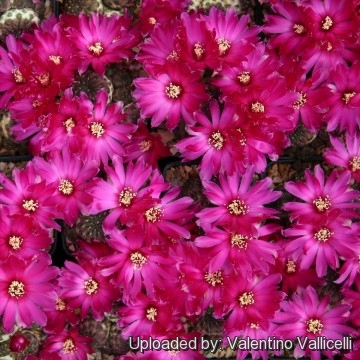
Sulcorebutia tarabucoensis subs. rauschii (Sulcorebutia rauschii) Photo by: Valentino Vallicelli
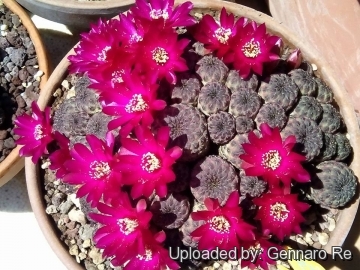
Sulcorebutia tarabucoensis subs. rauschii (Sulcorebutia rauschii) Photo by: Gennaro Re
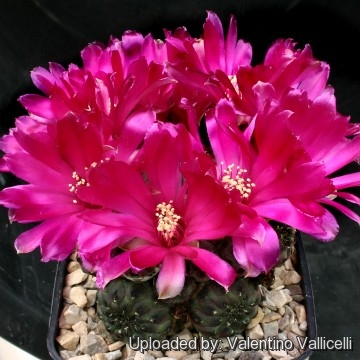
Sulcorebutia tarabucoensis subs. rauschii (Sulcorebutia rauschii) Photo by: Valentino Vallicelli
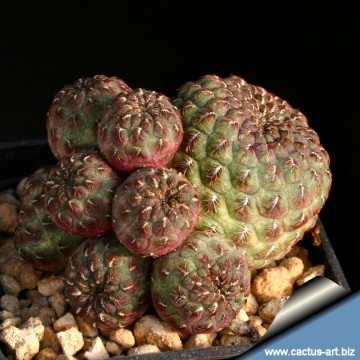
Sulcorebutia tarabucoensis subs. rauschii (Sulcorebutia rauschii) Photo by: Cactus Art
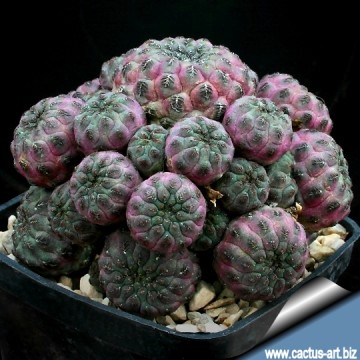
Sulcorebutia tarabucoensis subs. rauschii (Sulcorebutia rauschii) Photo by: Cactus Art
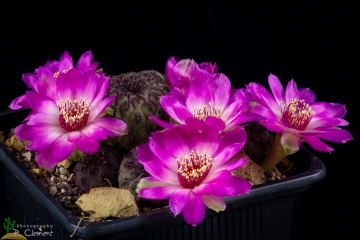
Sulcorebutia tarabucoensis subs. rauschii (Sulcorebutia rauschii) Photo by: Peiffer Clement
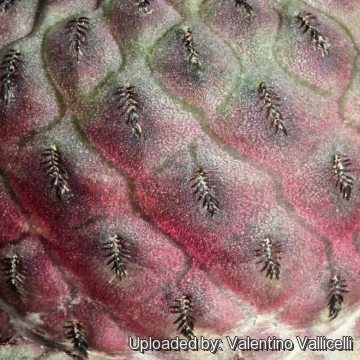
Sulcorebutia tarabucoensis subs. rauschii (Sulcorebutia rauschii) Photo by: Valentino Vallicelli
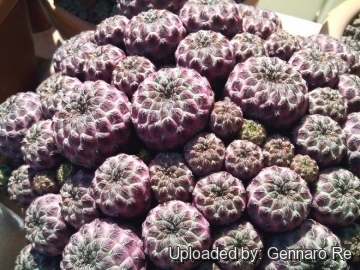
Sulcorebutia tarabucoensis subs. rauschii (Sulcorebutia rauschii) Photo by: Gennaro Re
Cultivation and Propagation: Rebutia rauschii is a mountainous plants with a thick taproots and is susceptible to overwatering, it grows rather slowly and need a very good drainage to avoid rotting. It requires also an appropriate air circulation and is sometime grafted to avoid root problems.
Soil: It loves a very permeable, coarse mineral soil.
Repotting: It require a deep pot suited to accommodate the swollen root, repotting with fresh potting-mix should be done every other year or when the plant has outgrown its pot. However, repotting doesn't necessarily mean they'll need larger containers. To prevent rottenness it is also advisable to surround its root neck by very rough sand or grit, this help a fast water drainage.
Sun Exposure: Light shade when young, full sun later ( light shadow my be useful in the hotsummer days)
Hardiness: Plants are and quite frost hardy -5 (-15)° C but preferably overwinter in a cool place (at 0/10°C). They need to be kept in a cool place during winter rest. This is important for the flowers, as well as for their health. Without this cool winter period, they normally won't get many buds.
Watering: It requires moderately watering through the growing season. This can be done weekly or more frequently during the summertime, if the weather is sunny enough, but allow to dry fully before watering again. Kept this way, plants will show a healthy growth. Keep rather dry as soon as the temperature starts dropping in October and keep it strictly dry throughout the winter quiescent period since ot is very sensitive to any moisture excesses. The plants may survives outside without protection in winter (cold hardy to -5° ) but is then somewhat prone to rot, too.
Fertilization: Give an occasional high potassium liquid feed during the active growing period.
Garden uses: It is a fine plant for a rock garden or container, contrasts well with agaves, yuccas, and low-growing flowering plants. Nice planted with Agave utahensisSN|581]]SN|581]], another very hardy species.
Pest and diseases: They are generally fairly easy to grow, especially if kept pest-free. They are susceptible to, scale insects and spider mite. Watch carefully for infestations of stem and root mealy bugs, and damage from these may well initiate fungal attack.
Propagation: Propagation: Seed, cutting, grafting. Take cuttings spring or summer, let them dry till the ends callous well. Then replant them in fresh cactus soil that is ever so slightly moist, and keep it that way till they root. Surface sowing is the best; seeds germinate in 14-28 days at 20° C, remembering that seedlings dislike strong light and dry conditions.
| Your Actions | |
|---|---|
| Back to Sulcorebutia index | |
| Back to Cactaceae index | |
 |
Back to Cacti Encyclopedia index |
Privacy stantement - Terms and conditions - How to cite - About us - Feedback - Donate




